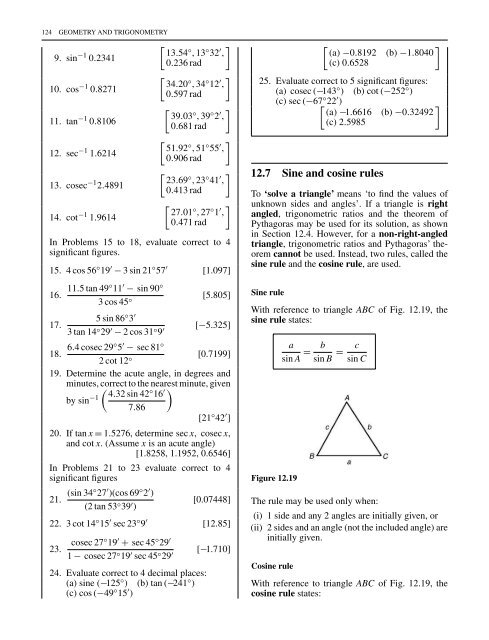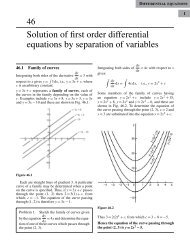trigonometry
Create successful ePaper yourself
Turn your PDF publications into a flip-book with our unique Google optimized e-Paper software.
124 GEOMETRY AND TRIGONOMETRY<br />
9. sin −1 0.2341<br />
10. cos −1 0.8271<br />
11. tan −1 0.8106<br />
12. sec −1 1.6214<br />
13. cosec −1 2.4891<br />
14. cot −1 1.9614<br />
[<br />
13.54 ◦ ,13 ◦ 32 ′ ]<br />
,<br />
0.236 rad<br />
[<br />
34.20 ◦ ,34 ◦ 12 ′ ]<br />
,<br />
0.597 rad<br />
[<br />
39.03 ◦ ,39 ◦ 2 ′ ]<br />
,<br />
0.681 rad<br />
[<br />
51.92 ◦ ,51 ◦ 55 ′ ]<br />
,<br />
0.906 rad<br />
[<br />
23.69 ◦ ,23 ◦ 41 ′ ]<br />
,<br />
0.413 rad<br />
[<br />
27.01 ◦ ,27 ◦ 1 ′ ]<br />
,<br />
0.471 rad<br />
In Problems 15 to 18, evaluate correct to 4<br />
significant figures.<br />
15. 4 cos 56 ◦ 19 ′ − 3 sin 21 ◦ 57 ′ [1.097]<br />
16.<br />
11.5 tan 49 ◦ 11 ′ − sin 90 ◦<br />
3 cos 45 ◦ [5.805]<br />
17.<br />
5 sin 86 ◦ 3 ′<br />
3 tan 14 ◦ 29 ′ − 2 cos 31 ◦ 9 ′ [−5.325]<br />
18.<br />
6.4 cosec 29 ◦ 5 ′ − sec 81 ◦<br />
2 cot 12 ◦ [0.7199]<br />
19. Determine the acute angle, in degrees and<br />
minutes, correct ( to the nearest minute, given<br />
4.32 sin 42<br />
by sin −1 ◦ 16 ′ )<br />
7.86<br />
[21 ◦ 42 ′ ]<br />
20. If tan x = 1.5276, determine sec x, cosec x,<br />
and cot x. (Assume x is an acute angle)<br />
[1.8258, 1.1952, 0.6546]<br />
In Problems 21 to 23 evaluate correct to 4<br />
significant figures<br />
21.<br />
(sin 34 ◦ 27 ′ )(cos 69 ◦ 2 ′ )<br />
(2 tan 53 ◦ 39 ′ )<br />
[0.07448]<br />
22. 3 cot 14 ◦ 15 ′ sec 23 ◦ 9 ′ [12.85]<br />
23.<br />
cosec 27 ◦ 19 ′ + sec 45 ◦ 29 ′<br />
1 − cosec 27 ◦ 19 ′ sec 45 ◦ 29 ′ [−1.710]<br />
24. Evaluate correct to 4 decimal places:<br />
(a) sine (−125 ◦ ) (b) tan (−241 ◦ )<br />
(c) cos (−49 ◦ 15 ′ )<br />
[ ]<br />
(a) −0.8192 (b) −1.8040<br />
(c) 0.6528<br />
25. Evaluate correct to 5 significant figures:<br />
(a) cosec (−143 ◦ ) (b) cot (−252 ◦ )<br />
(c) sec (−67[ ◦ 22 ′ )<br />
]<br />
(a) −1.6616 (b) −0.32492<br />
(c) 2.5985<br />
12.7 Sine and cosine rules<br />
To ‘solve a triangle’ means ‘to find the values of<br />
unknown sides and angles’. If a triangle is right<br />
angled, trigonometric ratios and the theorem of<br />
Pythagoras may be used for its solution, as shown<br />
in Section 12.4. However, for a non-right-angled<br />
triangle, trigonometric ratios and Pythagoras’ theorem<br />
cannot be used. Instead, two rules, called the<br />
sine rule and the cosine rule, are used.<br />
Sine rule<br />
With reference to triangle ABC of Fig. 12.19, the<br />
sine rule states:<br />
a<br />
sin A =<br />
Figure 12.19<br />
b<br />
sin B =<br />
c<br />
sin C<br />
The rule may be used only when:<br />
(i) 1 side and any 2 angles are initially given, or<br />
(ii) 2 sides and an angle (not the included angle) are<br />
initially given.<br />
Cosine rule<br />
With reference to triangle ABC of Fig. 12.19, the<br />
cosine rule states:










